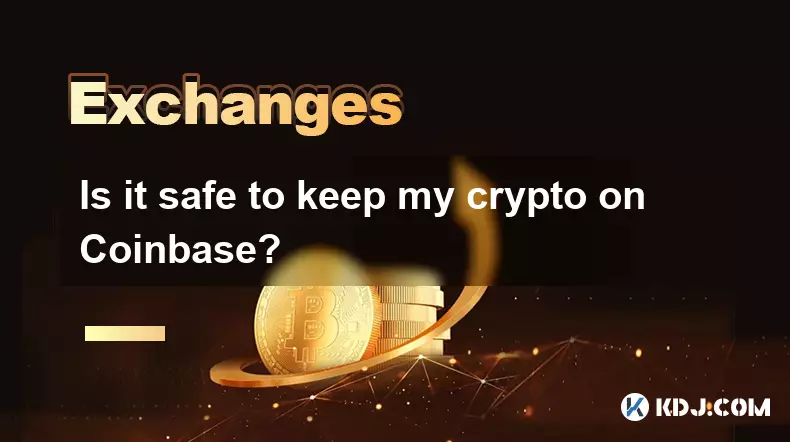-
 bitcoin
bitcoin $107015.826941 USD
-2.18% -
 ethereum
ethereum $3637.352324 USD
-5.18% -
 tether
tether $0.999831 USD
-0.02% -
 xrp
xrp $2.338078 USD
-6.23% -
 bnb
bnb $998.272150 USD
-6.97% -
 solana
solana $167.598257 USD
-10.12% -
 usd-coin
usd-coin $0.999863 USD
0.01% -
 tron
tron $0.282573 USD
-5.09% -
 dogecoin
dogecoin $0.169891 USD
-7.39% -
 cardano
cardano $0.557554 USD
-7.03% -
 hyperliquid
hyperliquid $39.914802 USD
-5.85% -
 chainlink
chainlink $15.414549 USD
-9.97% -
 bitcoin-cash
bitcoin-cash $510.361911 USD
-4.26% -
 ethena-usde
ethena-usde $0.999194 USD
-0.03% -
 stellar
stellar $0.282092 USD
-6.07%
Is it safe to keep my crypto on Coinbase?
Coinbase secures 98% of assets in cold storage, uses multi-sig wallets, and has crime insurance, but users face risks from phishing, SIM swaps, and lack of private key control.
Oct 13, 2025 at 08:36 pm

Understanding Coinbase’s Security Infrastructure
1. Coinbase operates one of the most regulated cryptocurrency platforms in the United States, adhering to strict compliance standards set by financial authorities. This regulatory alignment enhances user trust and ensures that operational practices meet legal benchmarks for data protection and asset custody.
2. The platform stores approximately 98% of its users’ digital assets in offline cold storage systems. These air-gapped environments are physically isolated from the internet, drastically reducing exposure to remote hacking attempts and large-scale cyber intrusions.
3. Coinbase maintains crime insurance coverage for digital assets held across its storage systems, protecting against theft, cybersecurity breaches, and physical loss. This insurance does not cover losses due to individual account compromises such as phishing or device breaches but safeguards the custodial reserves managed by the exchange.
4. Multi-signature wallet protocols are employed to authorize transactions, requiring multiple cryptographic approvals before funds can be moved. This layered authorization process adds a robust defense mechanism against unauthorized withdrawals.
User Account Protection Measures
1. Two-factor authentication (2FA) is strongly encouraged and integrated into every Coinbase account. Users can enable 2FA via authenticator apps or security keys, significantly reducing the risk of unauthorized access even if login credentials are compromised.
2. Session monitoring and anomaly detection systems actively analyze login patterns and transaction behaviors. Unusual activities trigger immediate alerts and temporary restrictions, allowing users to verify legitimacy or lock their accounts remotely.
3. Biometric login options, including fingerprint and facial recognition, are available on mobile devices to strengthen access control beyond traditional passwords. These features reduce reliance on easily phished textual credentials and improve personal device security.
4. Email and SMS notifications provide real-time updates on deposits, withdrawals, and setting changes. While SMS-based alerts carry inherent risks due to SIM-swapping threats, pairing them with app-based 2FA mitigates potential exploitation.
Risks Associated with Exchange-Based Storage
1. Keeping crypto on any centralized exchange inherently introduces counterparty risk. Even with strong security, users do not hold private keys, meaning they rely entirely on Coinbase’s operational integrity and availability during market volatility or technical failures.
2. Regulatory actions or government seizures could result in temporary freezes on funds. Historical precedents from other exchanges demonstrate that legal disputes or compliance investigations may restrict user access without immediate recourse.
3. Phishing attacks targeting Coinbase users remain prevalent, with counterfeit websites and fake customer support channels designed to steal login information and bypass 2FA protections. User vigilance is critical, as no amount of platform security can prevent socially engineered breaches.
4. Service outages during high-traffic events—such as major token listings or market crashes—can delay withdrawals. While these interruptions are typically short-lived, they highlight dependency on infrastructure stability when funds are not self-custodied.
Frequently Asked Questions
What happens to my crypto if Coinbase shuts down?
Coinbase is required to maintain customer asset records and has outlined procedures for returning funds in the event of insolvency. Historically, regulated exchanges under similar oversight have returned user holdings after ceasing operations, though the process may take weeks or months depending on legal proceedings.
Can the government seize crypto stored on Coinbase?
Yes, law enforcement agencies can issue asset seizure orders if illegal activity is suspected. Because Coinbase collects identity information through KYC verification, authorities can directly link accounts to individuals and compel the platform to freeze or surrender assets under court mandates.
Does Coinbase have a history of security breaches?
Coinbase has not suffered a major hot wallet breach resulting in customer fund loss. However, some users have reported account takeovers due to SIM-swap attacks and phishing. The platform itself has maintained its core custodial systems secure, but individual account vulnerabilities persist.
Is it better to use Coinbase Wallet instead of the main exchange?
Coinbase Wallet is a non-custodial solution where users control their private keys, offering greater autonomy than holding assets on the exchange. It functions independently from the Coinbase.com trading platform and connects to decentralized applications, reducing reliance on centralized infrastructure.
Disclaimer:info@kdj.com
The information provided is not trading advice. kdj.com does not assume any responsibility for any investments made based on the information provided in this article. Cryptocurrencies are highly volatile and it is highly recommended that you invest with caution after thorough research!
If you believe that the content used on this website infringes your copyright, please contact us immediately (info@kdj.com) and we will delete it promptly.
- Ripple Competitor Alert: Is Remittix the Next Top 10 Crypto Challenger to XRP?
- 2025-11-04 20:10:02
- MEXC, USDf, and Trading Volume: A Deep Dive into Recent Developments
- 2025-11-04 19:15:01
- Meme Coins and Market Dynamics: Navigating the Crypto Landscape in Late 2025
- 2025-11-04 20:10:02
- Bitcoin, Crypto, and EcoYield Bonus: Is This the Smartest Play Now?
- 2025-11-04 19:15:12
- Cardano (ADA) and Altcoin Growth: Navigating the Landscape
- 2025-11-04 19:15:12
- Solana ETF, Institutional Battle, and Western Union: A New Era for Crypto?
- 2025-11-04 20:10:01
Related knowledge

Common Mistakes to Avoid on OKX: A Guide for New Traders
Nov 04,2025 at 03:37pm
Understanding the Interface Before Trading1. New traders often jump into placing orders without fully exploring the OKX platform layout. Taking time t...

OKX TradingView Integration: A Guide to Advanced Chart Analysis
Nov 02,2025 at 03:37am
OKX and TradingView: Bridging the Gap for Professional Traders1. OKX, one of the leading cryptocurrency exchanges, has integrated with TradingView to ...

OKX Perpetual Swaps: A Comprehensive Trading Strategy Guide
Nov 04,2025 at 07:05pm
Understanding OKX Perpetual Swaps Mechanics1. Perpetual swaps on OKX are derivative contracts that allow traders to speculate on cryptocurrency price ...

OKX Trading API: A Developer's Guide to Secure Integration
Nov 02,2025 at 01:01am
Understanding the OKX Trading API Infrastructure1. The OKX Trading API is built on REST and WebSocket protocols, enabling developers to access real-ti...

Advanced Security Settings on OKX: Beyond Two-Factor Authentication
Nov 04,2025 at 05:25pm
Enhanced Authentication Mechanisms on OKX1. OKX has implemented advanced authentication layers that extend beyond standard two-factor authentication (...

OKX Asset Protection Fund: How It Secures Your Crypto
Nov 02,2025 at 11:19am
Understanding the OKX Asset Protection Fund1. The OKX Asset Protection Fund is a financial reserve designed to safeguard user assets in extreme market...

Common Mistakes to Avoid on OKX: A Guide for New Traders
Nov 04,2025 at 03:37pm
Understanding the Interface Before Trading1. New traders often jump into placing orders without fully exploring the OKX platform layout. Taking time t...

OKX TradingView Integration: A Guide to Advanced Chart Analysis
Nov 02,2025 at 03:37am
OKX and TradingView: Bridging the Gap for Professional Traders1. OKX, one of the leading cryptocurrency exchanges, has integrated with TradingView to ...

OKX Perpetual Swaps: A Comprehensive Trading Strategy Guide
Nov 04,2025 at 07:05pm
Understanding OKX Perpetual Swaps Mechanics1. Perpetual swaps on OKX are derivative contracts that allow traders to speculate on cryptocurrency price ...

OKX Trading API: A Developer's Guide to Secure Integration
Nov 02,2025 at 01:01am
Understanding the OKX Trading API Infrastructure1. The OKX Trading API is built on REST and WebSocket protocols, enabling developers to access real-ti...

Advanced Security Settings on OKX: Beyond Two-Factor Authentication
Nov 04,2025 at 05:25pm
Enhanced Authentication Mechanisms on OKX1. OKX has implemented advanced authentication layers that extend beyond standard two-factor authentication (...

OKX Asset Protection Fund: How It Secures Your Crypto
Nov 02,2025 at 11:19am
Understanding the OKX Asset Protection Fund1. The OKX Asset Protection Fund is a financial reserve designed to safeguard user assets in extreme market...
See all articles










































































